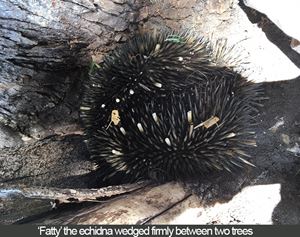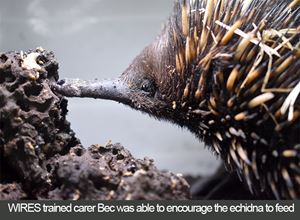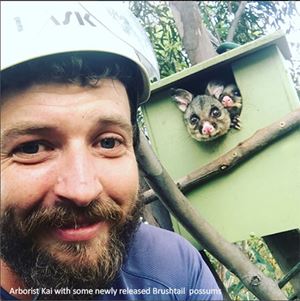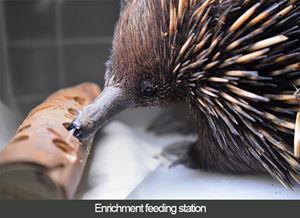How to rescue an echidna
Monday, December 18, 2017
There is a Short-beaked echidna somewhere in the wilds of north west Sydney, who has been given a second chance thanks to WIRES and wildlife heroes Salina and Bec.
Given increased development, this area of Sydney has seen an increase in the number of echidnas coming into care in recent months.
“That’s the third one I’ve cared for this year,” said Bec. “We’ve got so much development in the area, the poor things are being driven out of their homes.”

WIRES rescuer Salina answered the call to help the echidna who was found by a homeowner’s dogs in her backyard.
“He had been in the position where we found him for four days,” said Salina, adding that the house was located across the road from where new housing was being constructed. “We initially thought he was stuck but he’d actually dug himself in.”
Realizing that it was a two-person job to extract the echidna, Salina returned the next day with another experienced WIRES rescuer.
They were able to gently move the echidna and take him to a vet where he was found to have a scratched beak and injured leg.
“We get them out of harm’s way,” said Salina. “But we try to get them back out in the wild as quickly as possible.”

That’s because, at this time of year, echidnas may have a puggle in a burrow which can only survive for four to five days without their parent.”
Affectionately known as Fatty, the echidna was a very large example of his species, although it wasn’t possible to tell whether it was in fact male or female.
“He was massive, he would fill the bottom of a plastic garbage bin,” said Bec.
“He loved his food but because of his sore beak, he had to be encouraged to go foraging for food."
This was achieved by first using a bowl with sections that the echidna had to lick around and then using an enrichment feeder that Bec has made for captive echidnas.
You can see in the photo, the enrichment tool has holes that encourage the echidna to search for food inside.
“Finally he was ready to start hunting for his own food,” said Bec. “That’s when I managed to get him a termite mound which he managed to break open.”
Satisfied that he could feed himself in the wild, Bec was able to release Fatty into the bushland near where he had been found initially.
“Echidnas are territorial… there’s no point trying to relocate them because they will just go back to where their burrow is,” said Bec.
The same is true for possums and gliders. They must be released as close to their rescue location as possible.
Would you like to give a Christmas present to an echidna? Watch our short video to find out how… it might not be as easy as you first think!


Recent Posts
WIRES launches its first wildlife rehabilitation centre - Mullyang
WIRES Emergency Response in the wake of ex-tropical cyclone Alfred
International Women’s Day Volunteer Spotlight: Shelley
Tropical Cyclone Alfred – Emergency Wildlife Advice
Interview with WIRES Training and Development
Celebrating Women in Science: The Journey of Holly, Wildlife Conservationist and WIRES Team Member
